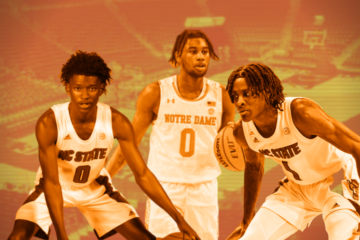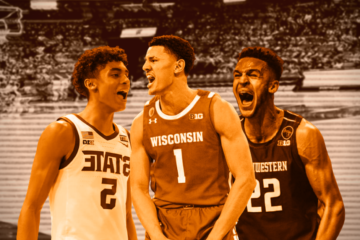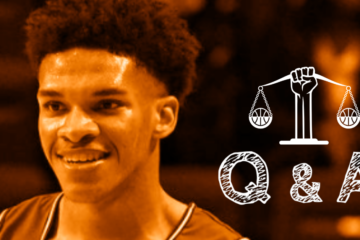While the international basketball community is already eagerly awaiting the 2023 NBA Draft featuring 2004-born French sensation Victor Wembanyama, the 2003 generation offers an intriguing combination of both upside and depth and could have a lasting impact on the landscape of the league. Tracking 2003-born prospects throughout the 2021-22 season will be a particularly exciting process, not only due to the diversity of the internationals who are draft-eligible for the first time, but because the 2022 NBA Draft marks the first year in which foreign players can fully take advantage of the multitude of pre-draft professional paths that have recently emerged all over the globe. Adding to the “traditional” routes (domestic European leagues, NCAA…), tailor-made pathway programs such as the G League Ignite, the Next Stars initiative of the NBL, and the newly formed Overtime Elite League (OTE) have revolutionized the draft process and will create compelling storylines going forward.
With the start of the season right around the corner, this three-part series intends to serve as a primer for anyone looking for an introduction to the top newly eligible foreign prospects ahead of the 2022 NBA Draft. Part 1 will highlight the preseason top four international prospects on the Rookie Scale 2022 Consensus Big Board. Parts two and three will check in on other draftable, stashable, and long-term prospects throughout the course of their initial draft-eligible seasons.
Disclaimer: The increasing global footprint in the NBA has trickled down to even the prep levels in the States. It has become increasingly common for teenage basketball prodigies from across the border and around the globe to attend high school at powerhouse programs in the United States. As such, the designation of a true “international” prospect can be a bit blurred and subjective.
This series will solely focus on players who have spent the majority of their respective youth careers outside of the American basketball system and have spent a maximum of one full season in the US until this point. For this reason, potential draftees such as Caleb Houstan, Moussa Diabaté, Ryan Nembhard, etc. will not be covered.
Yannick Nzosa
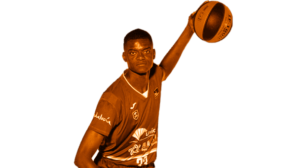
7’0” | 215 lbs. | D.R. Congo | Málaga (ACB, BCL) | 11/15/2003 | Rank: 7
For several years, Yannick Nzosa has been widely regarded as the big prize of the 2003 international prospect class and is the highest ranked 2022 NBA Draft prospect that plays overseas. Growing up in the Democratic Republic of the Congo, Nzosa started out as a soccer goalkeeper (a likely root for his impressive hand-eye coordination) before eventually being introduced to the game of basketball at the age of 12. After making quick strides, the young Congolese prodigy drew the attention of Stella Azzurra Roma and went on to join the Italian blue chip talent factory in 2017. Nzosa’s star rose to a different level after a standout performance at the 2019 Adidas Next Generation Tournament (ANGT) in Kaunas, earning all-tournament team honors at the age of 15. Following a controversial and extensive bargaining process, Nzosa left Italy in March of 2020 and signed a five-year contract agreement with Unicaja Malaga that supposedly includes an NBA and Euroleague buyout clause worth approximately 1 Million €. Unlike most young big men that see their first rotation minutes in the pros, Nzosa quickly adjusted to the steep step-up in competition and immediately had a positive impact for Unicaja (65.5 TS%, 7.2 BLK%, 2.3 STL%), with the team posting a 14.5 Net Rating throughout Nzosa’s play in 40 games of action in the ACB and Eurocup.
The foundations of Nzosa’s sky-high potential that have scouts buzzing are his unique physical tools. It is rare to find a teenager his size with such natural mobility all over the court. Nzosa covers ground seemingly instantaneously and possesses the lateral quickness to keep up with ball handlers on the perimeter – quite rare for a teenager with a 7’0’’ frame and a significant plus-wingspan.
Since the pick-and-roll has established itself as the premier group-tactical action to generate offensive advantages, it has become a critical skill for big men defenders to take away passing and driving angles for the opposing ball handler while continuing to contain the roller. While there are certainly macro-level ebbs and flows as to how pick-and-rolls actions are most stoutly defended, the current NBA landscape sees a high volume of drop coverage in the regular season and a higher demand for coverage versatility in the postseason. This creates a value juxtaposition for traditional big men. Nzosa is far from traditional.
Versatile, multi-coverage bigs of Nzosa’s ilk can provide surplus value and stay on the floor in the high leverage stages of big games (for a comprehensive overview of the different pick-and-roll coverages and their respective demands for bigs, be sure to check out PD Web’s excellent SFDE series). While Nzosa makes his share of classic youth/inexperience-based mistakes (being on the wrong side of the screen, allowing the roll man to get behind, etc.), he has shown the necessary signs that he can be proficient at literally any pick-and-roll coverage scheme. While defending below the screen, Nzosa deters ball handlers effectively by fluidly flipping his hips and manages to backpedal while applying pressure with his length and verticality. Above the screen, his lateral speed and ability to change directions comes in handy and can wreak havoc for handlers.
As the primary rim-protector, Nzosa has an uncanny knack for covering large distances and recovering back to the rim in the blink of an eye. His sense of timing as a shot-blocker makes it exceedingly hard for opponents to finish around him. A diminishing factor to his rim presence at this juncture is his slim frame. Despite Nzosa’s often textbook verticality, stronger bigs frequently manage to bump him off his spot by sealing him away, backing him down in the post, or lowering their shoulder when attacking in a straight line.
On the offensive end, Yannick Nzosa’s role for Unicaja is primarily as a play finisher with 36.2 percent of his offensive output resulting from pick-and-roll finishes, according to InStat. Nzosa’s rim gravity is especially apparent when he slips screens and dives to the basket, quickly recognizing open angles into the lane and leveraging his huge strides after the catch to generate high-level finishing opportunities. His explosiveness off a standstill doesn’t only give him a clear edge in transition as a highly effective rim runner, but is also an advantage against basically every ACB or Eurocup big in faceup situations in the half court.
While the path to an athletic rim-running NBA archetype is quite clear, that may be selling Nzosa a bit short. While he hasn’t had much opportunity to date in Spain, putting Nzosa in a position where he can make decisions at the elbows and top of the key with the ball in his hands may unleash further offensive dynamism. Especially in his past ANGT performances, Nzosa was able to showcase flashes of ball handling and playmaking proficiency in limited capacities. While a 4.65 AST% with Unicaja this past season may not indicate a clear necessity for increased playmaking duties, Nzosa has proven to be a fairly quick processor as a stationary passer in kickout and high-low situations. Giving Nzosa a longer leash to expand his horizons in DHO’s and short rolls could do wonders for his long-term development curve on the offensive end.
Nzosa’s quick adaptation to immediate positive contribution in the ACB should not be understated and has been another chapter of his steep development curve since being introduced to the game just five years ago. Heading into his pre-draft year, Nzosa finds himself in an intriguing situation with Málaga to solidify his draft stock. Having seemingly already developed trust in the coaching staff, Nzosa will face a plethora of high-level teams of varying play styles in the ACB and Basketball Champions League where he’ll have the opportunity to showcase his defensive versatility and offensive growth in a likely increased role. While his defensive talent is indubitable, NBA teams will closely monitor how much muscle mass he can add to his frame in the upcoming months. Similar to Evan Mobley, Nzosa’s limited upper and lower body strength will likely be a recurring topic in discussion regarding his potential to bang with bigger, stronger NBA bigs early in his career.
Nikola Jović
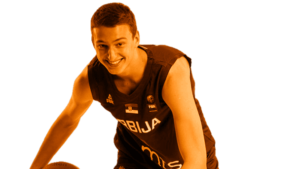
6’10” | 209 lbs. | Serbia | KK Mega Basket (ABA, KLS) | 6/9/2003 | Rank: 12
Serbian super agent Miško Ražnatović’s KK Mega Basket has been an NBA talent factory over the course of the past decade. NBA MVP, Nikola Jokic, is the headline, but other Mega draftees have included Ivica Zubac, Timothé Luwawu-Cabarrot, Vlatko Čančar, Goga Bitadze, Marko Simonović, Filip Petrušev, and more. Next up on this list of Mega to NBA success stories appears to be Nikola Jović.
Born in England as the son of a professional basketball player, Jović initially favored water polo before shifting his focus to hoops at the age of 13. Following substantial growth spurts and a window of limited exposure throughout the COVID-19 pandemic, Jović opened a lot of eyes at the 2021 ANGT in Belgrade, dominating against his peers with averages of 29.3 PTS, 10.3 REB, 4.5 AST and 1.8 BLK, ultimately being crowned the event’s MVP. Since this standout performance, Jović has solidified himself as a potential lottery selection and will draw significant scouting attention entering his first draft-eligible season.
When attempting to describe Nikola Jović’s game, the term “feel” immediately comes to mind. But what does “feel” really mean? It’s often a generalized term that gets folded in with “high IQ”, “intangibles”, etc. This is what inspired Evan Zaucha to formulate a meaningful definition, describing feel as “the sum of a player’s pattern recognition, visual processing (especially spatial recognition), and processing speed”. Jović excels in all these areas: his pattern recognition especially comes into play when he makes it past the first line of defense, enabling him to make sense of the immediate reactions of the opposing team defense. Thanks to his visual processing he consistently makes the right decisions based on the visual stimuli he receives – whether it entails lulling the low man with head and body fakes for a subsequent kick out pass or taking advantage of an open lane by himself. Finally, he possesses the necessary processing speed to maintain or increase the initial advantage created by a teammate with lightning-quick decisions right after the catch.
Jović may not be gifted with elite vertical athleticism, but he still has enough pop to finish above the rim from time to time and manages impressive overall rim scoring efficiency (61 FG% at the basket, per InStat). A fully ambidextrous finisher, Jović does an outstanding job shielding the ball against shot blockers and maintains control over his body in the air against contact. Thanks to his touch, he can effectively utilize finishing windows that open up while he is already on his way down.
A potential area for improvement in Jović’s multi-faceted offensive skill set is his consistency as a jump shooter from long range. In 17 total games (small sample size alert!) for Mega in various competitions this past season, Jović shot just 26.6% from deep on 3.8 attempts per game. Though there are several mechanical tweaks he has to tackle in the near future (follow-through sloppiness, inconsistent shot preparation, relatively slow mechanics, etc.), there aren’t any alarming red flags indicating that he won’t be capable of providing at least average shooting gravity over the long run. For many youngsters that experience a sudden growth spurt, it can take some time to grow into their body and make sense of the changed determinants for the energy transfer of the shooting motion. This might apply to Jović as well: in a video breakdown, Caine Purnell has pointed out that Jović used to be a great shooter at the age of 14, adding tape of an outing where he went 11-of-14 from deep. Moreover, the shooting numbers don’t appear to be that concerning when accounting for the context of shot difficulty when he took an array of tough, off-the-dribble attempts as the main offensive hub for Mega’s youth teams and the Serbia U19 team. Per InStat, Jović connected on 8-of-22 (again, small sample size) total catch and shoot threes – a respectable 36.4% clip.
What could turn into a recurring issue for Jović, though, is his on-ball defense. Shifty ball handlers repeatedly manage to beat him into the lane, as Jović has trouble making quick lateral changes of direction, primarily due to his slow and stiff hips. The opposition often targets him by clearing the strongside and forcing him to defend on an island. Most recently, Bennedict Mathurin (currently ranked 13th on the Rookie Scale 2022 Consensus Big Board) took advantage of his matchup against Jović during the 3rd Place Game of the U19 World Cup and generated multiple quality paint touches with relative ease. While Jović’s physical limitations certainly hinder his point of attack defensive chops, he also has a tendency to surrender favorable angles toward the soft spots of the defense. Moreover, he is prone to overreact to crossovers or head and body fakes, giving his matchup an additional advantage creation edge. Tackling those technical shortcomings along with slowly, but surely improving his athleticism should be a difficult, but attainable task for Jović in the coming year.
Despite these on-ball struggles, Jović has shown that he can operate as a positive contributor to an overall team defensive scheme. He provides value by making basic reads such as timely X-Outs, deterring passing lane angles, helping at the nail, etc. Considering that off-ball team defensive aptitude is inherently a greater portion of one’s defensive contribution, Jović’s path to (at least) neutral defensive value may not be as rocky as it seems at first glance.
Nikola Jović projects to be the ideal connective tissue jumbo wing that every NBA team seeks. Even in case that the shooting doesn’t pan out, Jović has multiple skills that he can leverage to become a meaningful offensive contributor in the modern NBA. While his defense is unlikely to return a positive impact early on, he has displayed enough of a solid foundation with his combination of size and instincts to have confidence he won’t be a liability and will eventually be able to stay on the court in high leverage situations.
Jean Montero
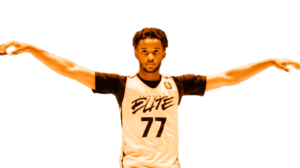
6’2 ½” | 172 lbs. | Dominican Republic | Overtime Elite | 7/3/2003 | Rank: 15
Despite a couple of prominent exceptions, the European talent development system has rarely brought up elite advantage creators. This is likely driven by the fact that European coaching philosophy, on the macro-level, tends to stress ball movement and seeking a “better shot” in the context of the team offense as opposed to reliance on a gifted downhill attacker greasing the offensive wheel. Jean Montero represents one of these rare exceptions (perhaps as a result of some of his foundational pre-high school development years taking place outside of Europe).
Born in the Dominican Republic, Montero grew up loving baseball, his country’s national sport, but also developed an affection for basketball at an early age. His international coming-out party was the 2019 U16 Americas Championship where he was an unstoppable force, finishing with averages of 30.3 PTS, 3.2 AST, and 3.3 STL. Subsequently, Montero received numerous options to advance his development and eventually opted to leave his home soil, making the move to Gran Canaria in Spain. In two seasons, Montero functioned as the main offensive hub for the club’s second team competing in 3rd division Spain (LEB Plata) while making a handful of short stint appearances with the main club’s ACB squad. In the meantime, Montero continued to impress on various international stages, winning MVP awards at both the 2019 ANGT in Valencia and the 2019 Basketball Without Borders Americas camp.
Montero once again made headlines this June when it became public that he will join the brand-new Overtime Elite League as the upstart league’s first international prospect. This deal could turn into a win for all parties involved, as Ignacio Risotto and Drew Mastin stated in one of their great podcasts for ID Prospects. Overtime gets a legitimately enticing NBA prospect that very much fits the company’s highlight-centric essence and Gran Canaria loans out Montero’s salary for one year to compensate for some of the losses experienced during the COVID-19 pandemic while maintaining player rights for an eventual buy-out. From Montero’s perspective, he has the opportunity to spend his pre-draft year in close proximity to NBA decision-makers in a favorable context for his style of play as a headliner for a platform that will drum up plenty of intrigue and exposure.
Back to further on-court scouting perspective on Montero’s game, as previously mentioned, his primary appeal derives from his capability to generate significant advantages with the ball in his hands. Montero’s most lethal tool for space creation is tight, quick ball handling with a wide variety of moves in his repertoire (right-to-left, left-to right, in-and-out, hang dribble, stutter rip, etc.) with the requisite fluidity and dexterity to make full functional use of said moves. Once he has created enough separation, it’s a tough ask for almost any defender to recover into adequate guarding position due to his explosive burst, shiftiness, and start-and-stop ability, all catalyzed by low center of gravity, bend, and flexibility. This lethal combination of skill, creativity, and burst enables Montero to routinely get both feet in the paint, collapse the opposing defense, and create efficient scoring opportunities for himself or a teammate.
Despite being rather thin and wiry, Montero asserts himself around the basket. While he could stand to improve upon his 50 FG% around the rim in Liga Plata action (per InStat) and become more comfortable with his off-hand, Montero is an unpredictable attacker for rim-protectors to account for due to his diverse array of finishing variations (jump stops, eurosteps, goofy-leg finishes, etc.). He has shown flashes of a floater that currently serves as an infrequent fallback option but very well could become a prominent and effective counter when facing drop-heavy schemes more frequently.
Another tantalizing aspect of Montero’s offensive game is his off-the-dribble shooting approach. Whether his momentum is carrying him east-to-west or north-to-south (or vice versa), Montero is remarkably comfortable shooting off-movement and does not appear to be gun shy in the slightest. On the flipside, this aggressive approach can lead to erratic shot selection (featuring long contested threes early in the shot clock) and subpar results (26.0 3P% on 4.8 attempts across all competitions). From a technical standpoint, his lower body mechanics could use some refinement. Montero usually has a valgus collapse which leads to inefficiencies and inconsistencies in his energy transfer. Moreover, his momentum can vary vastly between forward and backward fades when he hops into his shot. That being said, there is reason to be bullish on Montero’s long-term shooting projection given his opportunity to aggressively work through these kinks with a fair amount of creative freedom to make and learn from mistakes at a young age.
In order to fulfill his ceiling as a full-fledged bona fide NBA lead guard, Montero will need to continue making significant strides as a facilitator and playmaker. Since making the move to Gran Canaria, Montero’s overall advantage perception has made a leap as he has learned to be a more proficient game manager by controlling the tempo. Over the course of the 2020-21 LEB Plata season, Montero had a 1.5 AST/TO ratio – quite a feat for any young guard with a heavy on-ball diet and a near 30 USG%. While it’s important to remember that a low turnover rate isn’t necessarily a positive indicator if it’s driven by extreme risk-aversion, this doesn’t seem to be the case with Montero. He plays an aggressive style and deserves credit for not making typical, avoidable mistakes that most young lead guard prospects struggle with. He has shown strong ball security as a handler against pressure and his elite downhill advantage creation and rim pressure often lead to fairly wide passing windows. At the next level, more technically sound, athletically gifted defenders will likely result in these windows significantly narrowing. While he may not be a creative passing savant at this point, Montero has certainly shown flashes that he is capable of finding his teammates in tight spaces via creative wraparounds and live-dribble passes.
Montero’s overall defensive engagement can best be described as up-and-down. When fully locked in, Montero can make life quite difficult for opposing ball handlers by applying pesty full-court pressure that leads to turnovers or deflections thanks to his lightning quick hands (this was especially apparent in his ACB action). On the other hand, he can be somewhat erratic in these situations, sometimes overpressuring at the expense of surrendering favorable driving angles that break down the defense and put his teammates into scramble mode. Once Montero figures out how to properly canalize his activity level, he has the potential to become a pesky point-of-attack presence going forward, but will likely continue to struggle in maintaining position against opponents with significant strength advantages for the foreseeable future. Off the ball, his quick hands add value in disrupting passing lanes, but in too many instances, Montero can be caught flat-footed, limiting his reactivity in ball hawking imprecise deliveries. Moreover, his overall positioning is recurrently problematic, as he is prone to either overhelp when one pass away and frequently misses rotations after being caught ball-watching. Montero has shown encouraging team defensive spurts and it’s possible that he brings a more consistent engagement as he matures and takes on a slightly less demanding offensive role.
Over the course of the forthcoming 2021-22 season, there surely will not be any shortage of Jean Montero highlights floating around the internet. By joining the Overtime Elite League, he is well set to both propel his personal brand and be more accessible for NBA front office members that have been bereft of in-person Montero scouting opportunities due to COVID-driven global travel restrictions. Over the long run, a key question will be how much value he can provide off-ball. Excluding his limited moments with Gran Canaria’s ACB team, Montero has always functioned as the de-facto offensive centerpiece and likely will fulfill this role again with OTE. Major swing skills to watch beyond his shooting consistency will be his reactive cutting and relocation skills in the flow of the offense.
Ousmane Dieng
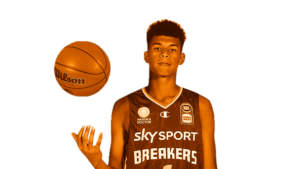
6’9 ¾” | 200 lbs. | France | NZ Breakers (NBL) | 5/21/2003 | Rank: 19
With traditional positional definitions continuing to diminish, the demand for big, multi-skilled wings is at an all time high and still far from being saturated. This is what makes Ousmane Dieng one of the most intriguing prospects in the 2003 international generation, as he possesses the building blocks of a prototypical dribble/pass/shoot swingman.
During his youth career, Dieng spent time in the renowned French talent factory INSEP in Paris which previously served as a monumental stepping stone for subsequent NBA players such as Tony Parker, Boris Diaw, Clint Capela and Evan Fournier. During the 2020-21 season, Dieng was a staple of the Nationale Masculine 1 (3rd division) affiliate team, Pôle France, averaging 12.6 PTS, 5.5 REB, and 2.7 AST in roughly 29 minutes per game. After drawing interest from various high-major NCAA programs and the G League Ignite, Dieng instead chose to join the New Zealand Breakers for his first draft-eligible season and become the first-ever European to participate in the NBL’s Next Stars program.
Over the course of the last several years, Dieng has continuously grown and now has the makeup of a long wing. While the Breakers currently list him at 6’7’’’, he appears to be an inch or two taller on tape and was noted as being 6’10” in shoes by Mike Schmitz at a recent workout. Though his growth has been rather steady, his strength hasn’t fully caught up and there is certainly a lot of room remaining to fill out his frame.
At this juncture, Dieng’s ability to create his own shot off the dribble is arguably his most appealing trait on the offensive end and has a chance to translate fairly swiftly to higher levels of competition. Dieng has displayed a wide variety of stepbacks and side steps to create separation while maintaining balance, even though his stance occasionally can be a bit too narrow. Though his shooting efficiency might not be ideal at 27.3% from deep, Dieng managed to attempt 7.1 threes per game. His off the dribble attempts typically occured within the flow of the offense (after ball reversals or coming off wide pindowns). When appropriate, he shows patience in sizing up his opponent, getting to his spots, and leveraging his superior positional size/length to rise above the opposition for fairly clean looks.
Dieng’s composure as a handler at his size points toward some secondary creation upside. Even when pressured, Dieng typically manages to maintain ball control and is not prone to making unforced errors. He’s shown to be quite comfortable and accurate as a live-dribble passer and is capable of finding his teammates through slim passing windows, but could stand to be a bit less risk-averse threading the needle in the long run. For now, this creativity and aggressiveness as a passer is encouraging.
A key area for improvement remains his finishing as Dieng has yet to figure out a way to consistently finish at the rim. Though he regularly creates separation off the bounce to generate paint touches, his frame holds him back from maintaining balance while finishing against contact. To his credit, Dieng does not shy away from contact. He often attempts to attack the lane with a lowered shoulder, but remains too upright and predictable around the rim. By improving his technique and flexibility as a slasher and adding to his finishing arsenal, Dieng’s rim gravity could make a significant jump and ultimately lead to better, more efficient scoring opportunities for himself and his teammates.
While his most evident NBA-translatable skills currently lie on the offensive side of the ball, Dieng has displayed some interesting flashes that he could develop into a lengthy, multi-faceted defender. While Dieng’s lacking lateral agility as a defender in space and shaky screen navigation can be problematic against bursty guards, he has demonstrated some natural feel and awareness as a well-positioned team defender for rotations and closing off passing lanes. His plus-length enables him to impact the game from time to time as a weak side rim protector. If Dieng realizes his potential in these areas and learns to further leverage his wingspan to stunt and dig as an off-ball helper, he could provide legitimate two-way value for his eventual NBA franchise.
As Dieng makes the jump to the NBL, scouts will certainly be keying in on how the young Frenchman combats the inevitable challenges that come with a notably increased level of physicality. The NBL is a tough league and Dieng could very well go through an extensive adjustment period at the outset of the season. If he can add core strength, bulk up his frame a bit, and find creative ways to leverage his length to combat strength disadvantages, Dieng has the potential to join the conversation as the top prospect of 2003 international generation and the top international prospect of the 2022 NBA Draft. The NBL has been a nice place for handlers with size to develop and groom their game for the NBA within the Next Star program. While Dieng certainly doesn’t have the jumbo lead guard chops of a LaMelo Ball or Josh Giddey, he has potential to be effectively utilized as a second side initiator with a steady diet of on-ball reps without carrying the burdensome load of a primary creator. Having an experienced game manager like Peyton Siva next to him should help mitigate some initial growing pains and enable Dieng to explore his utility as a muti-faceted offensive contributor.
